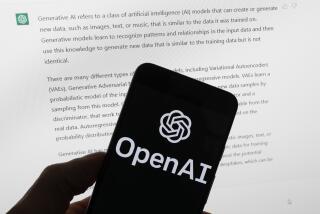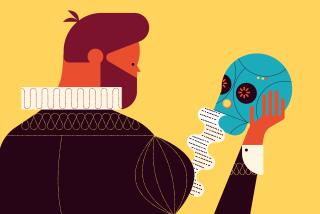The html Is on the Wall
- Share via
Few will argue with the idea that books and writing occupy a place of privilege in our culture--they contain our oldest stories and our history and ultimately contribute importantly to our sense of ourselves and our own humanity.
But what happens when the physical form and functions of books--the very technologies of reading and writing--start to change? According to Katherine Hayles, a UCLA English professor, literature itself will transform, and not just in the way stories are told, but in the sorts of stories that can be created. It’s a process that has already begun.
In this newly digitized electronic age of interconnected Internet Web texts, hypertext links, multimedia and CD-ROMs, reading already isn’t what it used to be, says Hayles, whose research focuses on the intersections of science and the humanities.
“For 400 years the physical interface with which we’ve encountered texts has been relatively constant and now, with computers, for the first time that’s changing,” says Hayles. “So the next obvious question is, how does the physical form of the text affect the meaning of the text?
“I think the electronic revolution is profoundly changing literature, going right to the heart of the fundamental notions of how a reader responds to a text, of what a writer is and even what a text is,” she says.
The newest generation of readers, for example, is the first to be schooled in the nonlinear style of reading that’s found on the World Wide Web, where documents are often electronically linked in potentially endless series of connections.
“When people navigate the Web, they don’t necessarily think of navigating in hypertext, but what they are doing is unconsciously absorbing new assumptions of what it means to read,” says Hayles.
From this “hypertextualized” generation of readers will emerge a new sort of writer and new kinds of literature, she believes.
Perhaps computer technology’s first major effect on literature will be the growth of multi-threaded narratives--stories that can move in several directions simultaneously and arrive at several different endings, or plots that never really end at all but keep jumping sideways to newly created possibilities.
Equally revolutionary is the interactive possibility of electronic literature. While traditional stories have one destiny that’s controlled by the author of the text, stories created through the electronic media can allow the reader to interact with the text, changing the relationship between writer and reader.
This is not the first time technology has altered writing and literature, Hayles says. The invention of photography, for example, can be linked to a sharp reduction in the number of pages that novelists spent describing landscapes in their works.
Hayles’ own career is a blend of science and literature. She started out as a research chemist, obtaining a master’s degree and working for several years in laboratories. But the life of the lab was not for her, and in the early 1970s Hayles returned to school, obtaining a doctorate in renaissance literature. She settled into what looked to be a life of musty tomes and Shakespeare lectures.
“I continued to be fascinated with scientific development, particularly the ways that literature and science come into the same areas of study at the same time,” Hayles says.
With the spread of computers and Internet-based writing, she found she couldn’t ignore the growing sense that reading electronic media was essentially different than reading books.
Will computers make books extinct? Hayles doesn’t think so.
“Oh, I think books are going to be around for a long time,” she says. “They’re a wonderful technology. They always work when you open them, and they can maintain backward compatibility for hundreds of years.”
Freelance writer Paul Karon can be reached via e-mail at pkaron@pacbell.net
More to Read
Sign up for our Book Club newsletter
Get the latest news, events and more from the Los Angeles Times Book Club, and help us get L.A. reading and talking.
You may occasionally receive promotional content from the Los Angeles Times.










